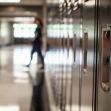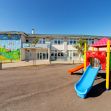A mom, Monica Mayes, went to a ballgame to see her son play. While sitting in a grassy area along the third-base line, she got hit in the face with a ball and suffered serious injuries, including skull fractures and brain damage. Since 1935, California courts have ruled that spectators assume the risk of injury when they take themselves out to the ballgame. A California Court of Appeals has rejected that decision and ruled that the injured fan may now proceed with her case.
Writing for a unanimous three-judge panel in the California Court of Appeal for Division Two of the Fourth Appellate District, Justice Richard T. Fields on January 7th reversed the decision of Judge Danial A. Ottolia of the Superior Court of Riverside County. Ottolia had granted summary judgment in favor of La Sierra, the private college that owned the baseball field. Judge Fields disregarded the 1935 precedent on which Ottolia had relied when he wrote “the primary assumption of risk doctrine” does not bar plaintiff’s negligence claim and may proceed to trial.
The appellate court opinion reviewed the requisite standard for granting a motion for summary judgment. They had to identify the issues to see if there was no factual basis for relief, determine whether defendant established facts that negated plaintiff’s claim, and decide if plaintiff showed the existence of a triable issue of material fact. He ruled all these elements were satisfied.
After reviewing the standard for reversing a motion for summary judgment, Fields explained the reason for reversing the 87-year-old “baseball rule,” which held that spectators assume the risk of injury from foul balls if they choose to sit in unscreened seats, even if no screened seats are available. In reversing the Superior Court’s decision, he wrote that the rule is “out of step with California’s primary assumption of risk doctrine.”
The judge explained that under California law, “everyone has a duty of care to not cause an unreasonable risk of harm or injury to others.” But, he acknowledged that courts find that sports are “inherently dangerous” so they impose only a “limited duty of care” on them. Courts, he explained do not want to “eliminate or mitigate the risks inherent in these activities” to an extent that alters their nature or inhibits vigorous participation in them.” Still, stadium owners, including those in collegiate sports, must take “reasonable measures to minimize the risk without altering the nature of the sport.”
Thus, the main issue in the case, according to Fields, was whether Mayes had raised “triable issues of material fact” regarding whether the private university La Sierra had a duty to install protective netting in areas that would protect spectators from foul balls. He distinguished Mayes’ case from the precedent where an injury occurred in a major league game. He then clearly and carefully explained “the baseball rule” that was gospel since 1935 which held that being struck by a ball is one of the “natural risks” of attending a baseball game is wrong. Furthermore, spectators have “full knowledge” of that risk.
The appellate court’s opinion explained that “the baseball rule does not account for the duties of owners “if such steps can be taken without changing the nature of the sport or the activity.” They said that “the scope” of La Sierra’s duty of care was a “triable issued of fact” and that “reasonable jurors could reach differing conclusions on issues such as the need to provide additional safe seating, install protective netting, warn spectators about the lack thereof, and exercise crowd control that would reduce near-field-obstacles that limited fans’ ability to see approaching foul balls.
The facts of plaintiff Monica Mayes’ case are instructive on the matter of risk assumption and what must be done to avoid putting oneself or others in danger. When Mayes attended her son’s intercollegiate baseball game, she sat behind the dugout on the third-base line, where there was no netting to protect her from foul balls. In her complaint, she wrote that La Sierra should have installed protective netting comparable to the netting that is present at her son’s home field at Loyola Marymount. She said she had been attending baseball games for 15 years and was not concerned for her safety because all the fields she visited had protective netting and she believed La Sierra’s did too.
In addition, La Sierra should have provided more screened seats, so she would not have had to set up her spot along the unscreened third-base line. She said she had no alternative place to sit. Also, the college should have warned spectators that the only screened seats were behind home plate and should have “exercised crowd control” to remove distractions, such as the many tents that spectators set up to watch the game and which blocked their view. In summary, she said La Sierra fell below the required standard of care.
Her case was aided by testimony from Gil Fried, an expert witness in “ballpark safety and management” who had testified in ten “foul ball and hockey puck-related cases.” The expert provided several facts that were damaging to defendant’s case. He said the spectator area was too close to the field and violated rules by the National Association of Collegiate Athletics (NACA) that required “60 feet of unobstructed space between the foul line and the fence around the field.” La Sierra’s distance was only 32 feet.
Fried also noted that La Sierra’s “raised dugout” and lack of personnel to exercise crowd control contributed to Mayes’ injury because other spectators in tents and near the field blocked her view and therefore her ability to see foul balls coming. He noted that Major League Baseball had adopted “protecting rules” in 2019 and concluded for these and other reasons that La Sierra’s field was “dangerous and substandard for a college baseball field.”
La Sierra countered, citing the assumption of risk statute and a section of the California Civil Code that immunized certain property owners. The court held that La Sierra was not covered by the cited Code section and focused on assumption of risk. In requesting summary judgment, La Sierra noted that it did not sell tickets, charge admission, or tell fans where to sit. They quoted their athletic director who said there “had been no reported incidents of a spectator being injured by a foul ball” until Mayes. They also said no organization, such as NACA, required safety netting and argued “it is a “normal occurrence” for balls to be batted outside the field of play and into the spectator seating areas.”
It may be normal, but now it’s foul play. The court remanded the Mayes case to the trial court and told it to enter an order to deny La Sierra’s motion for summary judgment.






